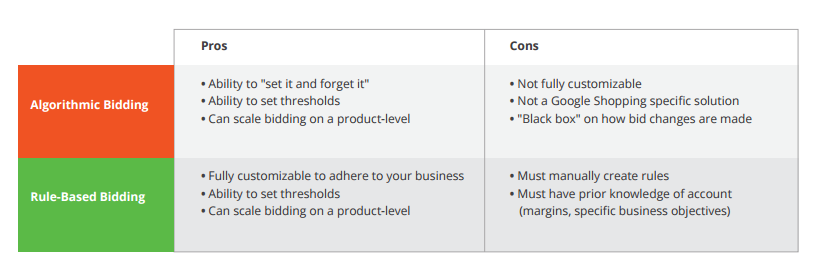Programmatic Bidding for Google Shopping Advertisers


Optimizing a Shopping account with a large product catalog is a daunting task, which is why so many brands and retailers turn to automated technology for their bid management.
Programmatic (automated) bidding can alleviate the guesswork associated with Shopping campaign management. Each type of automated bid strategy is designed to help a retailer achieve a specific goal for their business (example: increase volume or revenue).
Rules or algorithms are then applied to your campaigns to meet that specific objective.
Shopping practitioners with a large number of SKUs understand how time consuming manual bid management can be. If applied correctly, automated bid technology can help retailers streamline their bidding process, save time, and optimize product-level campaign management and efficiency.
There are two automated bid management options available to practitioners:

Algorithmic bidding is based off a retailer’s financial objective(s). Due to it’s “hands off” appeal, it is a popular management tool among practitioners today.
Example: Your Company Wants To Optimize Their Campaign For A Target ROAS Of 10:1
With Algorithmic-based bidding technology, the platform will register the request, and automatically make adjustments to the campaign, using it’s own algorithm, to meet the new ROAS goal.
But, what may end up happening is in order to increase ROAS (revenue divided by cost) the algorithm will have to lower cost at a faster rate than it’s decreasing revenue.
So, what kind of an impact will this have on your top line as a business?
Even though you’re meeting the new ROAS target, you’re going to see a decline in revenue over time because you are pulling back on your investment in the Shopping channel.
Algorithmic says to input your target number and the algorithm will take care of the rest. But just because you are meeting those set targets, that doesn’t necessarily mean your campaign is doing well.
Automated algorithmic bidding tools lack control and customization for your specific business needs.
Although you may be thriving in one component of your business (ROAS), you could be sacrificing in other areas as seen in the image below:

Although we understand the appeal of automated “machine-learning” services that claim to provide intelligent bid adjustments to fit your Shopping campaign goals, automated algorithmic solutions have a steep learning curve.
It can take up to 90 days for machine-learning technology to gather enough data to start making educated adjustments to your campaign.
To be successful, these solutions must account for a wide spectrum of inputs and trends among businesses. Quite frankly, algorithmic automated bidding software companies have a platform to sell and the best way to market their tool is to use basic business algorithmic rules that can be applied to a mass of retailers.
Many of these platforms don’t understand the intricate components or competitive metrics that make your company tick.
At the end of the day, nobody knows your business better than your Shopping manager, who is working intimately within your campaigns on a regular basis.
This is why we believe it’s critical for advanced Shopping practitioners to implement automated custom rule-based bidding for the management of their Shopping campaigns.
In contrast to algorithmic bidding, rule-based bidding is a cost effective, efficient solution that allows for the scalable bid management of large inventory campaigns.
Under no circumstances should businesses hand over 100 percent of their campaign management to automated solutions. We believe in the hybrid approach of using advanced automated bidding tools in combination with a human element (the practitioner).
One of the main benefits of leveraging automated rule based bidding is the ability to set thresholds.
Threshold bidding is just one example of how retailers can set customized rules based on conversions, impressions, ROI, and trends, allowing them to make product-level changes to the account at scale.
With rule-based bidding you can be very specific and customize your inputs, as opposed to algorithmic bidding―which can be a ‘cookie cutter’ type software that has to be able to work for businesses of all different shapes and sizes.
Your business is unique and Marketing Managers should have access to the ability to build their own customized rules to fit their business needs. Most of these goals are very specific to each retailer and automated rule-based bidding technology is built to account for the gaps and lack of customization found within algorithmic bidding platforms.
For more on programmatic bidding, email [email protected]
